This recipe is part of our collection of Fried & Baked Dim Sum Dishes. Sign up for our newsletter to get recipes, dining tips and restaurant reviews throughout the year!
Taro root dumplings (aka wu gok) are made from taro that is steamed and mashed, stuffed with diced mushrooms, shrimp, pork and scallions, and then finally deep fried.
Taro is easy to work with. It’s a root vegetable closely resembling a potato that’s white inside with beautiful purple flecks. By making taro root dumplings at home, you avoid the fillers you may find at lower-quality dim sum restaurants, resulting in a dumpling wrapper that’s noticeably light and fluffy.
Making taro root dumplings takes the better part of an afternoon, beginning with a trip to Chinatown for a few select ingredients. You’ll need to pick up taro root, Chinese dried mushrooms, Chinese 5 spice powder, Shaoxing rice wine and tang flour, none of which may be available at your local grocer.
I’ve learned that the devil in this recipe is in the prep work. Stay patient and organized as you chop, dice and fill, and you’ll produce a dim sum classic that delights with a crisp exterior and a deliciously-savory filling. The payoff for your effort is great!
One last important tip to mention is to fully chill the filling before stuffing the dumplings, and then to fully chill the dumplings before deep frying. If you forget either of these steps, the dumplings are likely to fall apart during cooking and undo all of your hard work!
Here’s how to make taro root dumplings, step-by-step. The detailed tutorial with pictures is at the bottom of the page.
Can you share any expert tips from your experience making taro root dumplings? Want to ask a question before you try making it yourself? I’d love to hear from you in the comments section below!
Taro Root Dumplings Recipe
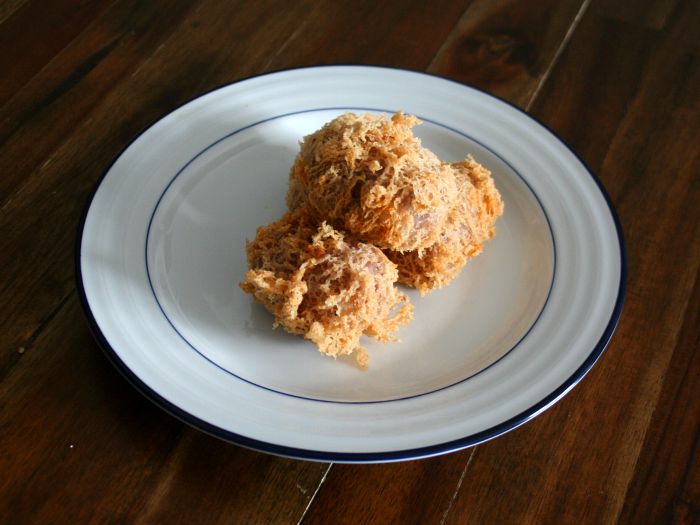
Makes: 24 | Prep Time: 2 to 4 Hours | Cook Time: 10 Minutes
Adapted From: Edibly Asian
Ingredients
Filling:
3 Chinese dried black mushrooms
5 ounces lean ground pork
5 ounces fresh shrimp
1 green onion
2 cloves garlic
Pork Marinade:
1/2 teaspoon Chinese 5 spice powder
1 teaspoon dark soy sauce
1 teaspoon cornstarch
1/2 teaspoon sesame oil
Filling Sauce:
1/2 teaspoon salt
3/4 teaspoon chicken bullion
1/4 teaspoon sugar
1 teaspoon Shaoxing rice wine
1/2 tablespoon cornstarch mixed with 1 tablespoon water
Wrapper:
1 pound 5 ounces taro root
4 ounces tang flour (wheat starch)
4 ounces pork lard
1 teaspoon baking soda
1/2 teaspoon salt
1 tablespoon sugar
oil for deep frying
Directions
1. Soak the dried mushrooms in hot water for 20-30 minutes. Peel and devein the shrimp. Combine the marinade and sauce ingredients. Add the marinade to the pork and refrigerate for 15 minutes.
2. Peel the taro with a Chinese cleaver or kitchen knife, then cut into 1/2- to 3/4-inch slices. Cover and steam the taro for 30 minutes until the slices are soft. Move the steamed taro to a bowl and mash into a paste.
3. While the taro is steaming, prep the other filling ingredients. Squeeze any excess water from the mushrooms and remove the stems. Dice the pork, shrimp, green onion, garlic and mushrooms.
4. Stir fry the pork with the shrimp, garlic and green onions in 2 teaspoons of oil. Add the filling sauce and stir until it thickens. Remove the filling from the stove, transfer to a bowl and refrigerate for 2 hours until fully chilled.
5. Stir 3/4 cup of boiling water into the tang flour. Add the tang flour mixture to the mashed taro, followed by the lard, baking soda, salt, and sugar. Knead the dough into a ball, then cut the dough into 24 equally-sized pieces.
6. Create a depression in the center of the wrapper with your thumb, then add 1 rounded teaspoon of the chilled filling. Press the filling into place inside the depression, so that you can fold the wrapper neatly around the sides. Pinch the dumpling closed and mold into the shape of an egg. Repeat until all 24 dumplings are complete, then refrigerator for up to 2 hours.
7. Heat oil to 375 degrees. Deep fry the dumplings in batches for 2-3 minutes, removing once a fine netting appears on the surface of each dumpling. Serve immediately!
Step-By-Step Tutorial
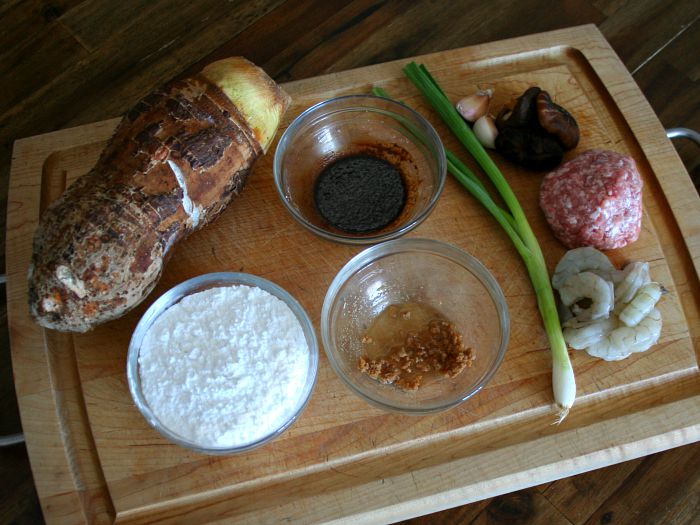
Start by gathering the ingredients. Soften the dried mushrooms by soaking in hot water for 20 to 30 minutes. Peel and devein the shrimp. Combine the marinade and sauce ingredients.
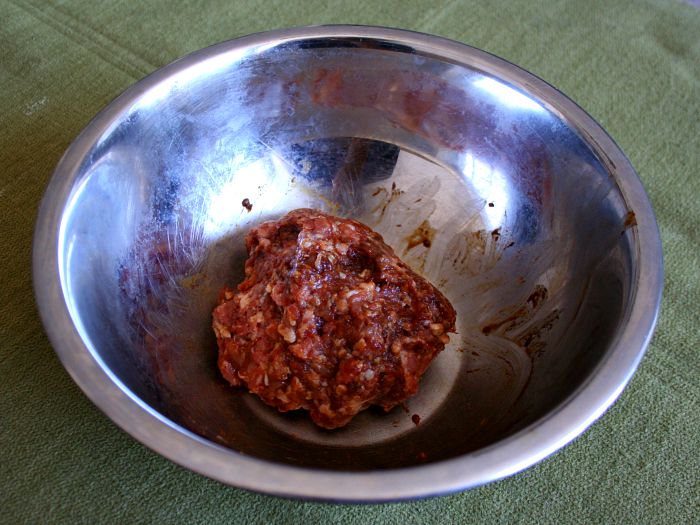
Combine the marinade ingredients with the pork and set aside in the refrigerator for 15 minutes.
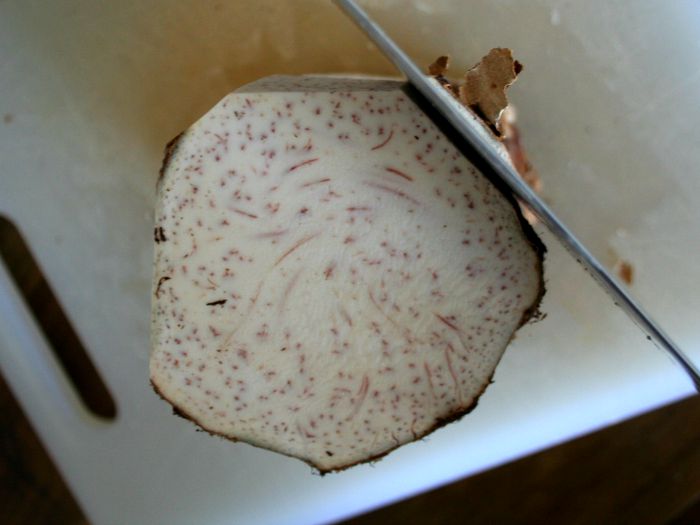
Peel the taro using a Chinese cleaver or kitchen knife. The taro skin is a bit tougher than a potato skin. Be careful with your fingers and make sure you don’t trim off too much of the meat inside.
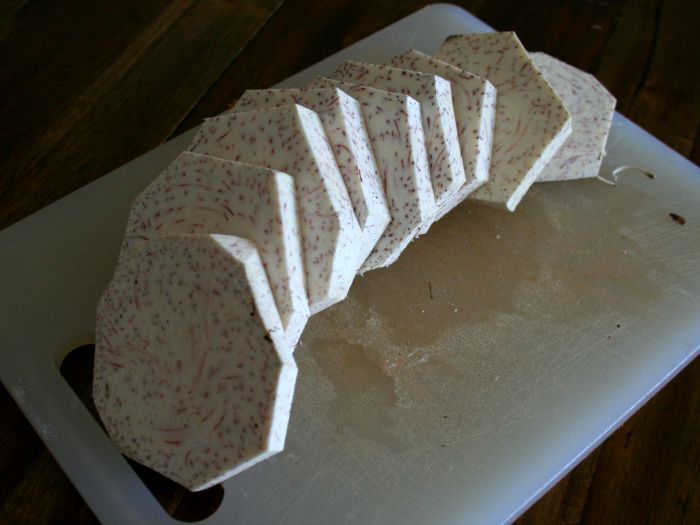
Cut the taro into slices that are between 1/2 and 3/4 of an inch thick.
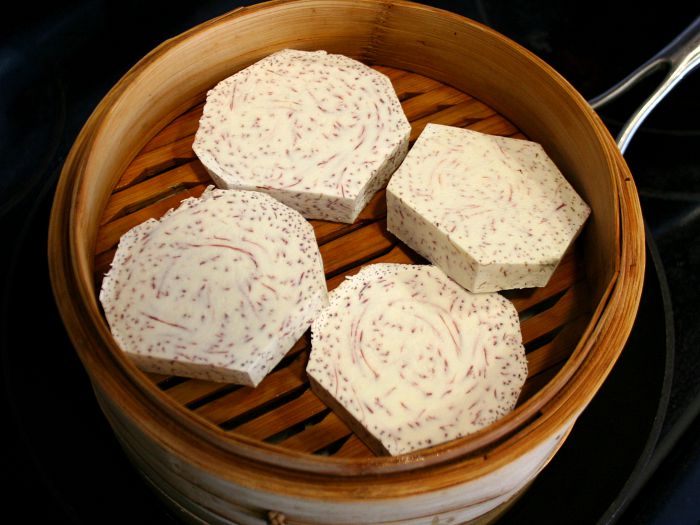
Cover and steam the taro for 30 minutes until the slices are soft.
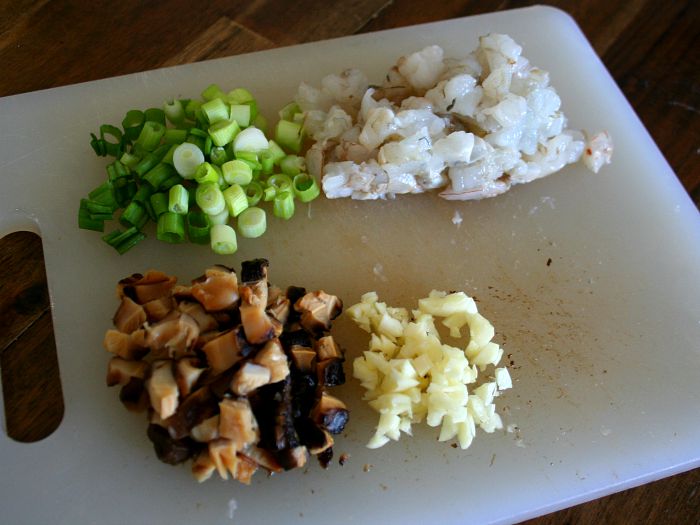
While the taro is steaming, prep your other filling ingredients. Squeeze out any excess water from the mushrooms and remove the stems. Dice the pork, shrimp, green onion, garlic and mushrooms.
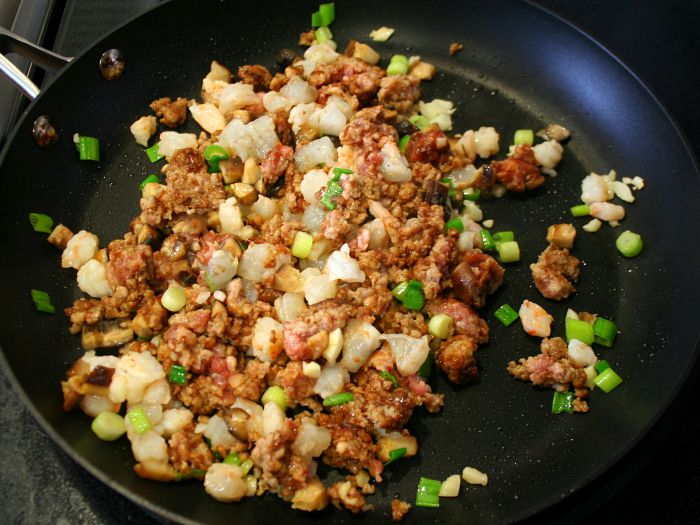
Stir fry the pork with the shrimp, garlic and green onions in 2 teaspoons of oil.
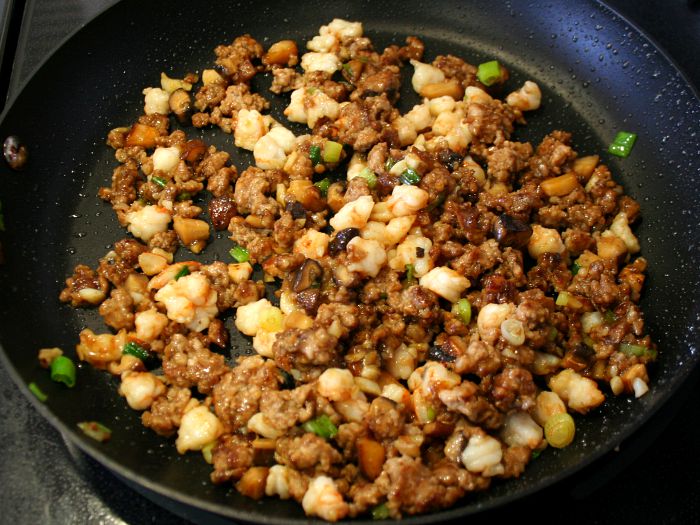
Add the filling sauce and stir until it thickens. At this point, remove the filling from the stove and transfer to a bowl. You’ll want the filling to be completely chilled before stuffing the dumplings. You can either store the mixture in the refrigerator for about 2 hours or in the freezer for about 30 minutes.
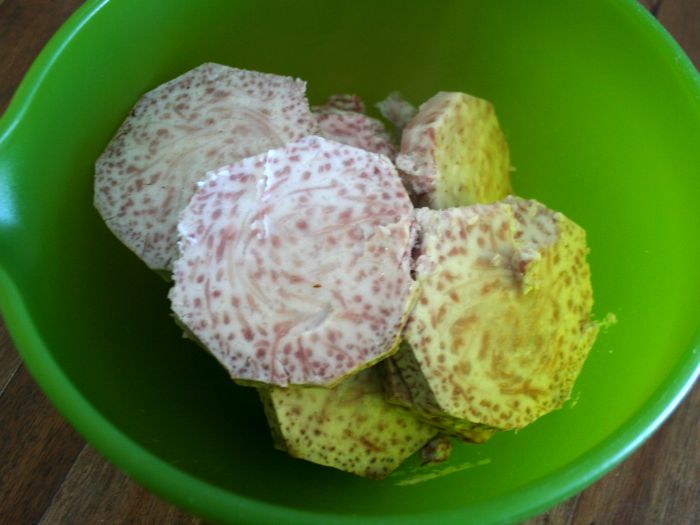
When the taro is done steaming, dump it into a bowl. You’ll notice that the taro is really soft and crumbly at this point.
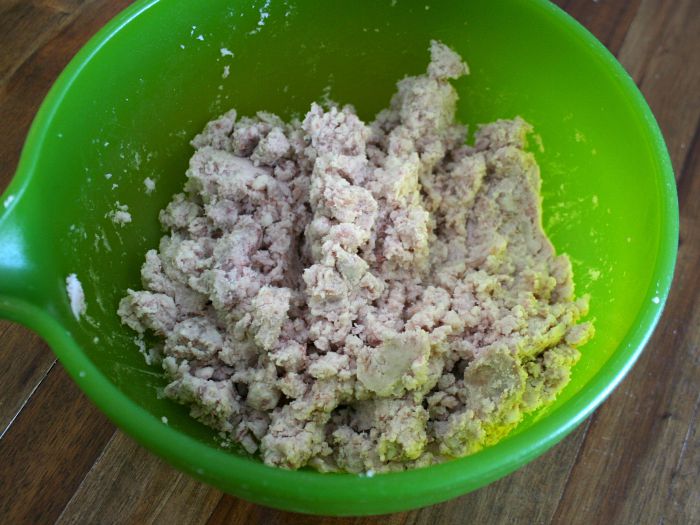
As soon as the taro is cool enough to handle, mash it into paste and do your best to squeeze out any lumps.
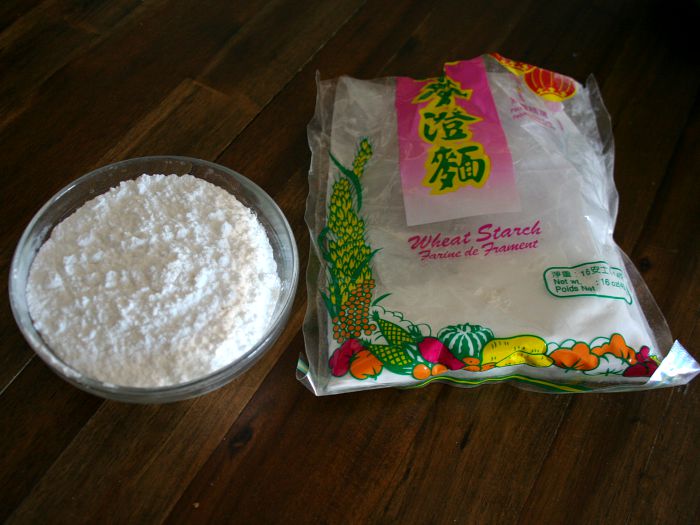
This is the tang flour, which has the consistency of cornstarch and which is used as the binding ingredient that holds the dumpling wrappers together.
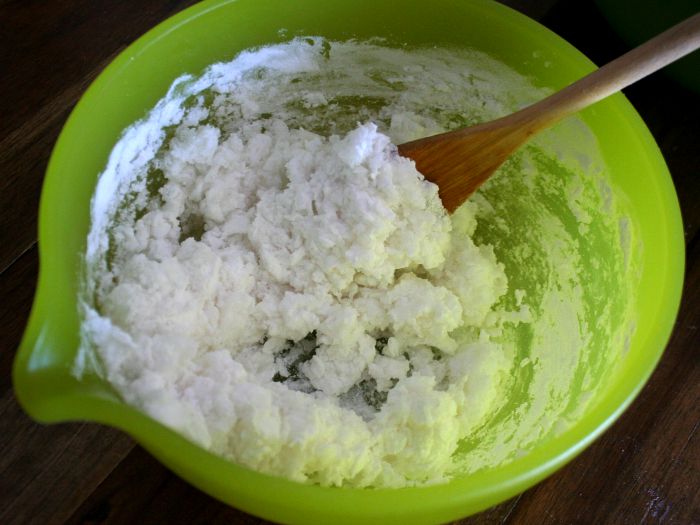
Add 3/4 cup of boiling water to the tang flour and stir it in. Move quickly, as the longer the water sits in the flour, the gummier it becomes.
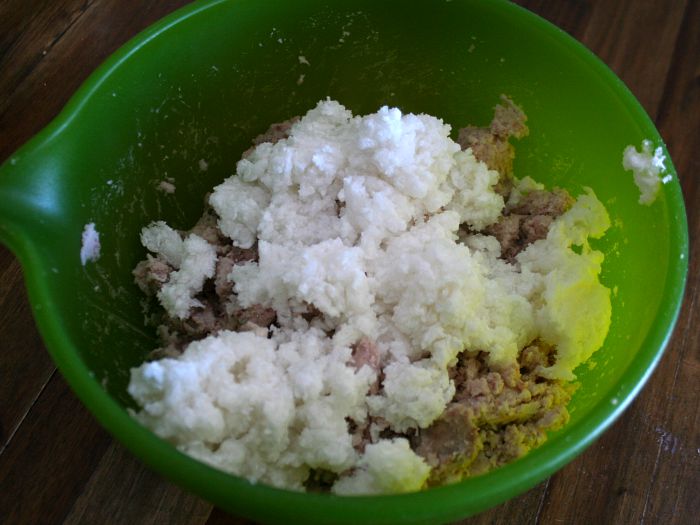
Add the tang flour mixture to the mashed taro, followed by the lard, baking soda, salt, and sugar. (If you can find pork lard to use, then bonus points for you. Otherwise, peanut oil will work fine.)
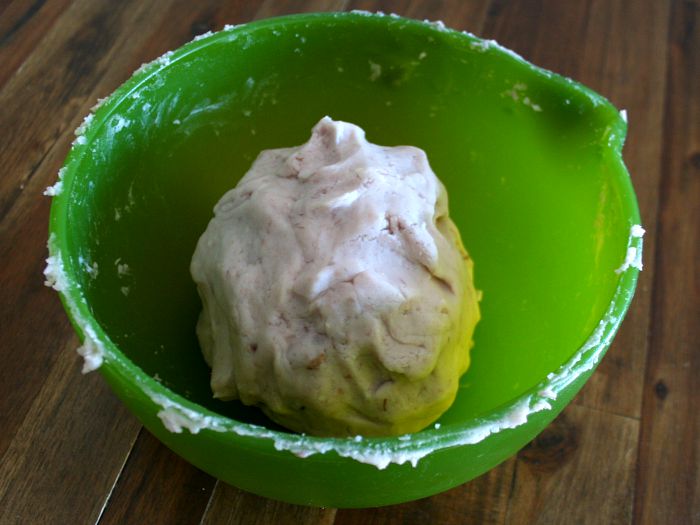
Knead the dough into a ball and remove any taro lumps as you go.
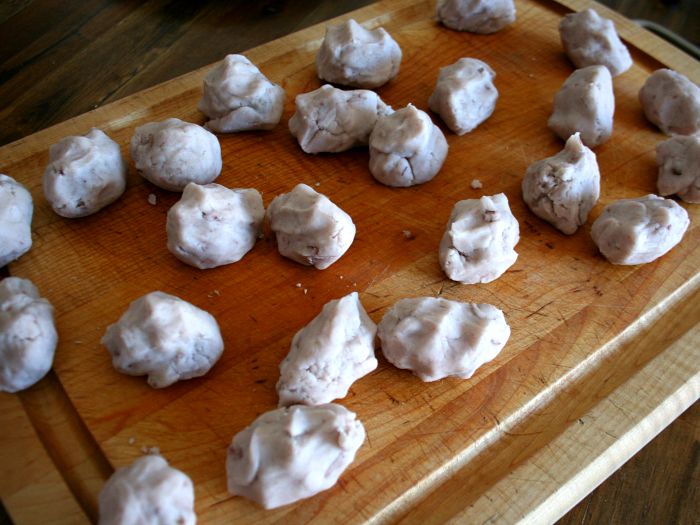
Cut the dough into 24 equally-sized pieces — these will be your dumpling wrappers.
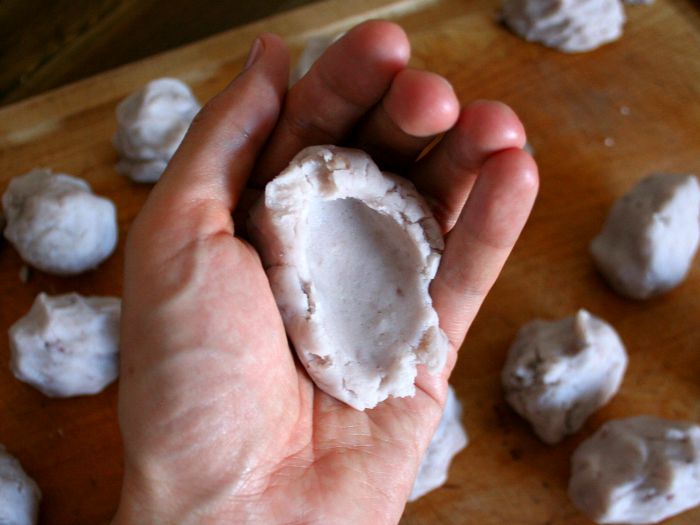
Create a depression in the center of the wrapper with your thumb.
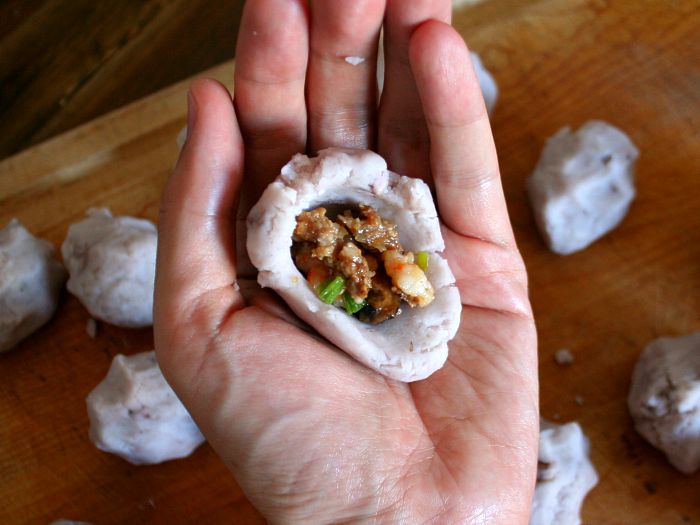
Add 1 rounded teaspoon of the chilled filling. The tendency is to just “place” the filling into the dumpling wrapper, which results in a lopsided dumpling because you end up stretching the sides of the wrapper over the top to close the dumpling. Instead, “press” the filling into place inside the depression, so that you can fold the wrapper neatly around the sides.
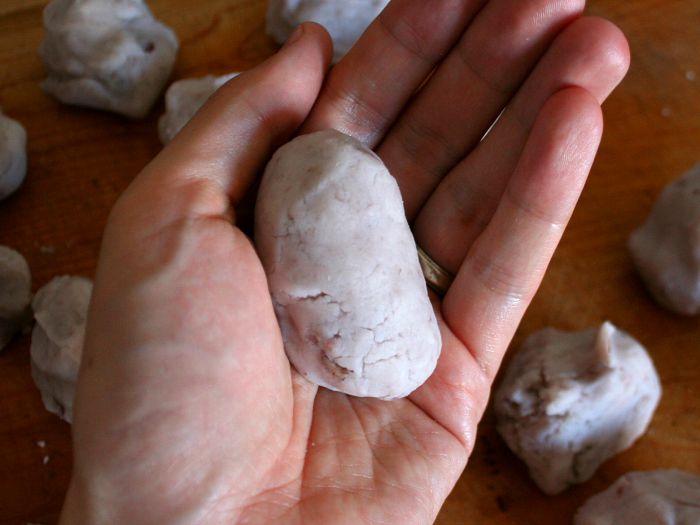
Pinch the dumpling closed and mold into the shape of an egg.
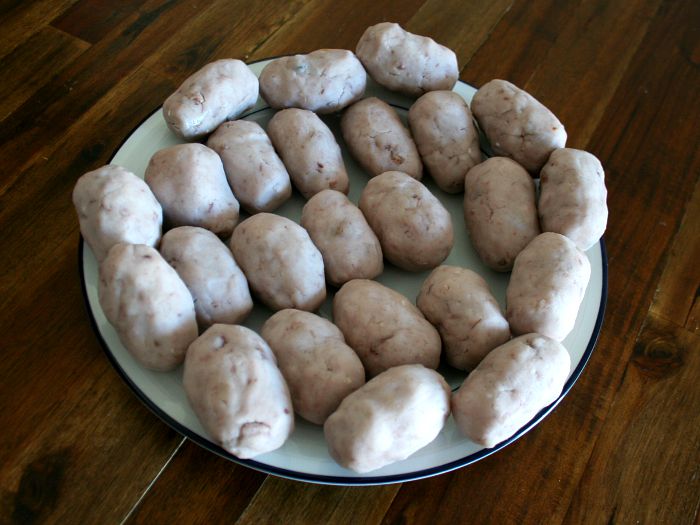
Repeat the steps above until all 24 dumplings are complete. The dumplings fry best if they’re fully chilled. Put the completed dumplings into the refrigerator for up to 2 hours.
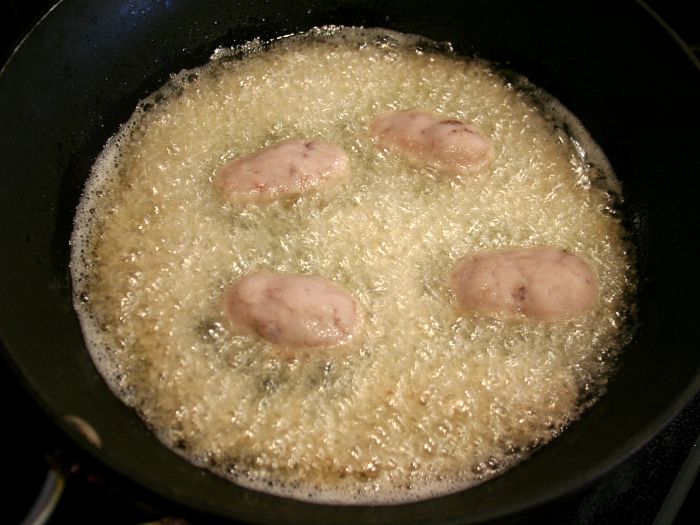
Deep frying taro root dumplings can be really tough. Do it wrong and they’ll basically disintegrate in the fryer. Here’s the right approach. First, make sure you have enough oil in your wok or deep fryer to cover the dumplings. If your dumplings are properly chilled, you should be able to fry them in batches until a fine netting appears on the surface, as pictured above. If you’re having trouble, dip the dumplings one at a time into the oil using a slotted spoon or small wire sieve. Holding the dumpling while it fries to a golden brown will keep the netting from drifting away from the dumpling.

As your taro root dumplings come out of the deep fryer, serve immediately! You can freeze any leftover dumplings you don’t fry for future use.
Learn more about Taro Root Dumplings from these Experts
Watch Giang make Taro Root Dumplings (VIDEO)
The future is now: fried Taro Root Dumplings from Gourmandistan
Yum Honey takes on Taro Root Dumplings at Maxim’s in Hong Kong
HT: Photo by Edsel Little via Wikimedia Commons.
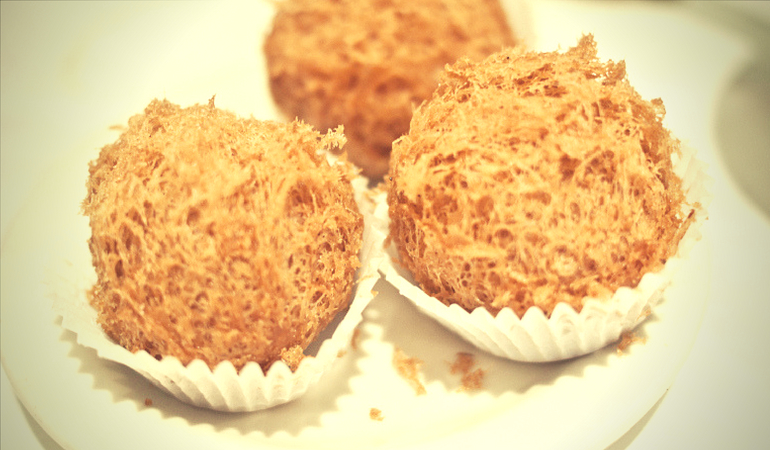




Taro Root Recipes | Laatuasunnot
[…] The Best Taro Root Dumplings Recipe | … – Taro root dumplings are made from taro root that is steamed and mashed, stuffed with diced mushrooms, shrimp, pork and scallions, then finally deep fried. Taro… […]
Pwave
Very happy with the outcome of this recipe. As good as what you get from a commercial tea house. Just a tip; make sure than you have enough oil so the dumpling is submerge. The crust will form and enclosed all around the ball. If not, the crust will peel off like old skin and desinigrate into the oil. This happened to me with my last few batches. Ball wasn’t thorough submerge and the crust did not form up top which caused the crust to collapse.
Thank you for the recipe 🙂
Dim Sum Central
So happy to hear your experience, and great tip! If you have trouble getting the taro wrapper to hold together when frying, it’s also helpful to check the shortening you’re using. The recipe calls for pork lard, which works best, but you’ll have trouble if you substitute say, Crisco. Another good option, if pork lard isn’t available is plain old corn oil. Happy cooking!
Tina
Hello, if I want to substitute lard with peanut oil how much should I use? Thank you. 🙂
Dim Sum Central
Hi Tina, thanks for getting in touch. Peanut oil is a great substitute for the lard (just don’t use Crisco!). 4 ounces of lard is equivalent to about 1/2 cup of peanut oil. The key is getting the consistency right. At the step above where you add the lard, baking soda, salt, and sugar to the wrapper dough, substitute the peanut oil and add it last. Drizzle the oil in until the dough forms a workable ball without becoming too oily to the touch. You may end up using slightly less than the full 1/2 cup. Hope this helps and let me know how it goes for you!
Joan Friend
Thank you for the recipe. What is the difference between tang flour and regular wheat flour we get at grocery stores?
Dim Sum Central
Hi Joan, thanks for your question. Tang flour is a type of wheat starch that you’ll commonly see used in Asian dumpling and bun wrappers, whereas wheat flour you’ll find in Western grocery stores is primarily used for bread, pasta and other “all-purpose” doughs. From what I understand, the primary difference is that tang flour has all the gluten removed, resulting in a transparent pastry dough. ~Wes
Nancy A.
This is my second failed attempt at making taro puffs. The first was a different recipe. Following your recipe and tips to adequately chill filling and dough I thought I had a winner…..however my dumplings still disintegrated. They were completely submerged in a deep fryer. I kept them chilled while a few were in the fried cooking. I used pork lard as well.
I still have uncooked dumplings in the fridge…..what went wrong?
Nancy
Dim Sum Central
I’m so sorry to hear that, Nancy. Very frustrating. There are a couple of things you can try. 1. Try steaming the taro root for less time. You want the taro to be soft after steaming, but want to finish the cooking process in the hot oil. 2. Further to this end, you can dunk the steamed taro in an ice bath to stop it from cooking as soon as you remove it from the steamer. 3. Pick a vegetable oil or peanut oil with a high smoke point, then fry on medium high to high heat, about 360-370 degrees. You essentially want to sear the outside of the dumpling to help it hold together.
Hope these suggestions help. I’m planning to make a batch in the next couple weeks. I’ll write with more, if I learn anything else new. ~Wes
gordon gimenes
Hi, I followed the recipe but used butter instead of lard. But my taro doesnt make the mesh part… Why is that? I have tried 3 or 4 different recipe and times, I didnt have tang flour before but i was able to get some and still the same result. Well it came out a little better. I was getting minor meshing. But not the huge one i see in resto. I just potato starch before. As it is hard to come by where i live. Im using a kitchen aid to mix. is that ok or it should be by hand?
Dim Sum Central
Hi Gordon, in this case, using the exact ingredients without substitutions will yield the best results. When it comes to frying the dumplings, using high heat is important. You’re essentially flash-frying the dumplings to produce the exterior netting and protect the integrity of the dumpling itself. Lower temperatures will slow the cooking process, causing the binding elements in the dumpling to melt and fall apart. ~Wes
Sofie
I used cold butter instead of lard and we only have wheat flour here. It keeps falling apart in the fryer. I still have a lot of wrapper dough left in the refrigerator and I hate to throw it away. Should I add more wheat flour and boiled water to see if it will hold up in the fryer?
Dim Sum Central
Hi Sofie, I’m so sorry to hear about your trouble. Unfortunately, I think you’ll run into trouble with that combination of ingredients. The tang flour and lard or oil are what you need to get successful results, in my experience. ~Wes
Hula
Wow this is a great and challenging dish. I was anxious to get started frying so I put some of the balls in the freezer to cool it quickly but failed in the frying. I tried cooling in the frig first but still failed in the frying. There were hopeful moments when it seemed like it was rolling in the oil only to find just a naked taro ball with all its goodness sunk on the bottom. Oh my! So here is how I finally had my first success:
1. Started with new oil (my testers had ruined the first pot).
2. Fried at 370 degrees.
3. Kept the taro ball trapped in the wire ladle, this minimized the skin floating away.
Thanks to all the responses made and replies from Wes, I slogged my way to success!
Mahalo!
Dim Sum Central
Hi Hula, I’m so happy to hear about your success — way to go! This is definitely a challenging dish and the frying point is the make or break! I’ll make these again soon and post back any further refinements! ~Wes
Ron Massaro
Hello i lov e this recipie, thank you. If we freeze any leftover, uncooked dumplings, how do we cook them from the freezer?? Do they need to thaw or straight from freezer to boiling oil?? Thanks again! Ron
Dim Sum Central
Hi Ron, I would definitely defrost before frying the leftovers. Otherwise, I would expect you would end up with a crispy exterior with a still-frozen filling. ~Wes
Maggie
Hi, I’ve just had a go at this, couldnt get pork lard so used butter. Bought wheat starch, not Tang, as it was all the Oriental store had but they assured me it was the same thing. I fried individually in a wok in sunflower oil but I must have made the balls too big and oil did not cover the ball. In order to submerge the ball I had to hold the wok tilted on its side. It was precarious as the bubbling oil threatened to overspill the wok but the ball came out perfectly. To cook remainining 3 balls I switched to a small tall saucepan…. each one failed!!! Bald balls! All crispy coating at the bottom. Conclusion – maybe it’s the wok?
Dim Sum Central
Thanks for your note, Maggie, and glad to hear about your efforts! I’m thinking I probably need to make a video soon to help everyone out with this one! ~Wes
Phu
Hello Wes, thanks so much for answering all trouble shooting that every one had, and Thks so much for being so generous possing your recipes.
My name is Phu and I have a question regarding to replace the ingredients. If I use Idaho potatoes and butter to replace the taros and lard. Will it still have the nesting texture when it frying? I tried this in the past but didn’t successfully.
Long ago I ate at one of American bistro they did this to the potatoes dumplings not stuff of anything. All they did is just scoop the batter out that was stored in the refrigerator and cook it as order and it have the taro text. I really love it so much. I wanted to duplicate the recipe and have searching for long time hope to find to the way but didn’t have any luck. I thought I may ask the you ( the experts) hope you can help. Thks so very much.
Wes Radez
Hi Phu, thanks for your question and kind words. Unfortunately, I’ve had experience that’s similar to yours. I’ve tried making the taro root dumplings with potato to see if it would work as a substitute and the experiment failed miserably. I imagine your American bistro used some sort of binding agent in the mashed potatoes to make them hang together and puff up, though I wouldn’t venture what that could have been! ~Wes
Jennie
Just came across your website. It is a beaut! Is there some way you could show a photo of the dim sum along with audio to show how to order it in Cantonese? Would bee cool, although most places have dim sum names with photos. Just a thought.
Wes Radez
Hi Jennie, please check out our dim sum menu guide! ~Wes
Leo Labrecque
Can I make the Taro dough ahead of time. If I do this,how long can I keep it in the fridge.
Wes Radez
Hmm, Leo. I think unfortunately this is going to be best to make as you use it. The taro dries out pretty quickly otherwise. ~Wes
Alice
Why does my Wu Kok dumpling does not have the light nesting when I cooked them? It has deep and hot enough oil .
Wes Radez
Hi Alice, I’m sorry that it’s difficult to say without being there in the kitchen with you! ~Wes
Elizabeth
Will you able to share the recipe for taro bun which has a sweet taste with taro filling and some kinds of flour outside it is soft like steam but also like baking !i hope you know what described not many dim sum place make this bun!,
Wes Radez
Great suggestion, Elizabeth. I’ll add that to my list of future recipe ideas. ~Wes
Vanin
I’ve only made this once a few years ago and they were only just ok– the recipe didn’t have all the tips you provided. It was definitely a lot of work for mediocre results but it’s my fave to order out. I’ll try your technique to see if it’s better! Thnks!
Wes Radez
Terrific, Vanin. Good luck! ~Wes